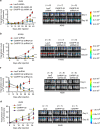DARPP-32 and t-DARPP promote non-small cell lung cancer growth through regulation of IKKα-dependent cell migration
- PMID: 29782621
- PMCID: PMC5959014
- DOI: 10.1038/s42003-018-0050-6
DARPP-32 and t-DARPP promote non-small cell lung cancer growth through regulation of IKKα-dependent cell migration
Abstract
Lung cancer is the leading cause of cancer-related death worldwide. Here we demonstrate that elevated expression of dopamine and cyclic adenosine monophosphate-regulated phosphoprotein, Mr 32000 (DARPP-32) and its truncated splice variant t-DARPP promote lung tumor growth, while abrogation of DARPP-32 expression in human non-small cell lung cancer (NSCLC) cells reduces tumor growth in orthotopic mouse models. We observe a novel physical interaction between DARPP-32 and inhibitory kappa B kinase-α (IKKα) that promotes NSCLC cell migration through non-canonical nuclear factor kappa-light-chain-enhancer of activated B cells 2 (NF-κB2) signaling. Bioinformatics analysis of 513 lung adenocarcinoma patients reveals elevated t-DARPP isoform expression is associated with poor overall survival. Histopathological investigation of 62 human lung adenocarcinoma tissues also shows that t-DARPP expression is elevated with increasing tumor (T) stage. Our data suggest that DARPP-32 isoforms serve as a negative prognostic marker associated with increasing stages of NSCLC and may represent a novel therapeutic target.
Keywords: Akt; DARPP-32; Erk; IKKα; NF-κB2; NSCLC; cancer; migration; survival; t-DARPP.
Conflict of interest statement
Competing Interests: The authors declare no competing financial interests and no competing non-financial interests.
Figures








Comment in
-
DARPP-32 and t-DARPP isoform in non-small cell lung cancer (NSCLC): could they drive patients' clinical management and be a therapeutic target?Transl Lung Cancer Res. 2018 Dec;7(Suppl 4):S326-S328. doi: 10.21037/tlcr.2018.12.06. Transl Lung Cancer Res. 2018. PMID: 30705846 Free PMC article. No abstract available.
References
Grants and funding
LinkOut - more resources
Full Text Sources
Other Literature Sources
Molecular Biology Databases
Miscellaneous

